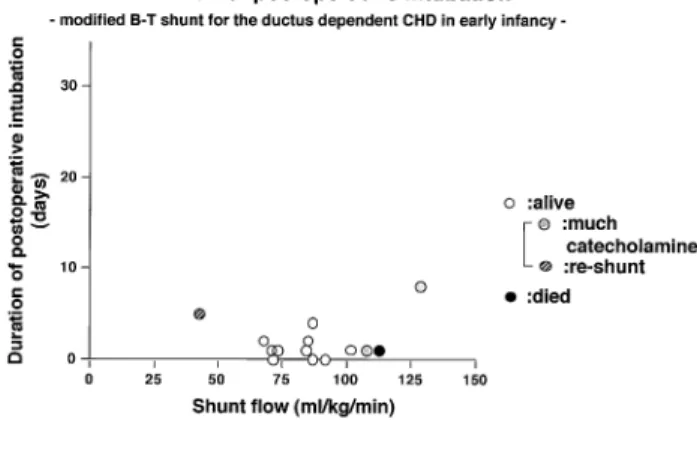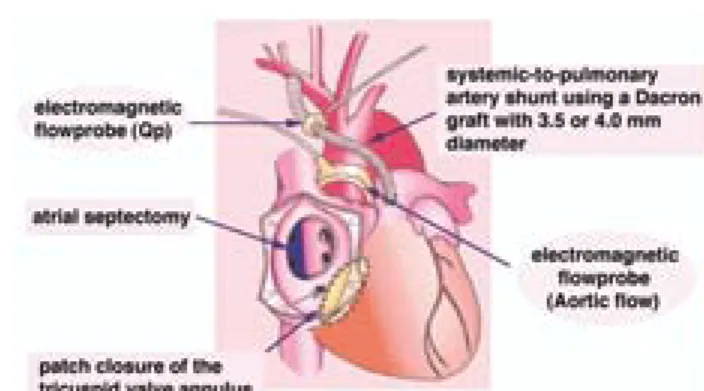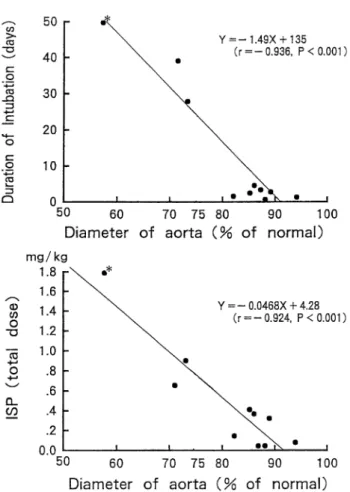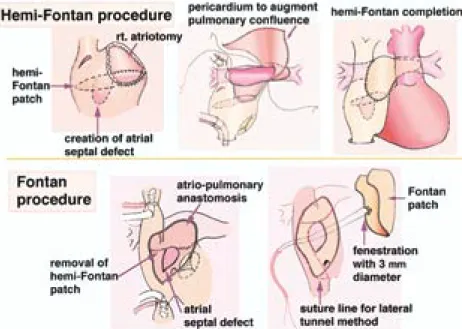はじめに 1968年4月25日,12歳の三尖弁閉鎖症児に試行された フォンタンの偉業達成以来,単心室を主病変とする様々 の複雑心奇形児に福音がもたらされた1)。右心バイパス 循環(フォンタン循環)とは,体静脈還流血を右室を経 由せずに肺動脈に導く右室を必要としない夢のような循 環である。その最終目標は,機能的単心室の容量仕事を 正常化することと,正常の動脈血酸素飽和度を得ること にある。この治療概念の導入と絶え間ない独創的な戦略 の開発により,先天性心疾患を有する全ての患児を,心 室形態と機能を中心 と す る 個 々 の 潜 在 能 力 を 考 慮 し て,2心室修復,1心室修復あるいはその中間型と,生 直後より将来を見つめて治療戦略のプロトコールにのせ ることが可能になってきた2‐9)。今回,我々の行ってき たフォンタン循環に関する基礎的,臨床的研究を中心に 述べることとする。 1)フォンタン循環が成り立つには? 正常循環は左室が担う臓器循環(体循環)と右室が担 う肺循環が直列につながれ,チアノーゼのない肺・体血 流量比が1の効率のいい循環である。一方,全ての単心 室類似疾患では,乳児期早期の生理的肺高血圧のために, 体循環と肺循環が並列につながれて生まれ,動・静脈血 がミキシングするためのチアノーゼと単心室に対する慢 性的な容量負荷により,やがて心室機能低下を招く。そ こで,チアノーゼをなくし,単心室のボリュームワーク を正常化するには,単心室が担う体循環の後に肺循環を 直列につなぎ,右室を必要としないフォンタン循環につ なぎかえる必要がある。この循環が安全に成立するには, 毛細管内圧が血液の通常の膠質浸透圧25!Hg をこえる と血!成分が血管外へ漏出して循環血液量を維持できな いので,そうならないような中心静脈圧の低さ,肺血管 抵抗の低さ,心室機能の良さ等の条件が必要である。そ して生理的肺血管抵抗の経年的推移からすると,それは 新生児期をすぎて半年ほどの間にどんどんさがって成人 のそれに近ずくので,フォンタン循環は少なくとも生後 半年以降に適応すべきといえる。 代表的なフォンタン循環適応例として,左室の低形成 と大動脈弁,僧帽弁及び上行大動脈等の一連の左心系統 の低形成を伴う左心低形成症候群がある。この疾患では, 唯一の機能心室である右室から起始する肺動脈(肺循 環)につながる動脈管が流出路となって脳循環,冠循環 及び腹部循環等の体循環の全てが支えられている。つま り肺循環と体循環が並列で,通常来るべき,新生児期早 期の生理的な動脈管の狭小化により体循環の虚脱と肺 うっ血を来し,生命の危機に陥り,ショック状態で来院 し,なんらかの外科治療を必要とすることになる。この 疾患の頻度は,先天性心疾患の1.4−3.8%といわれ,先 天性心疾患患者の新生児期死亡の約1/4を占める比較的 頻度の高いものである。 1983年に,この左心低形成症候群に対して,乳児期早 期に生存可能な並列循環をつくる Norwood 手術が発表 された2)。その骨子は(1)肺動脈を離断して大動脈と つなぎ,憂いのない体循環流出路を作成する,(2)適 切な体・肺動脈短絡術により肺血流量を規制する,(3) 十分な心房間交通を作成する3点からなる。そしてしか るべき後に二期的にフォンタン手術を施行することにな るが,うち最難関の Norwood 手術を乗り越えるには, 肺血流量の安全域が極めて狭く,生理的及び人工心肺の 影響から肺血管抵抗が急速に変動する術後早期にはその 規制が最もやっかいで,体・肺動脈短絡サイズが少し大 きすぎると,肺循環に血流量がシフトして体循環虚脱を 招き,あるいは少し小さすぎると高度のチアノーゼを来 し,患者の将来をきめる key point になる。
総
説
進化する右心バイパス循環
北
川
哲
也,
北
市
隆,
筑
後
文
雄,
川
人
智
久
徳島大学医学部附属病院心臓血管外科 (平成12年7月11日受付) 四国医誌 56巻4号 136∼144 AUGUST25,2000(平12) 1362)乳児期早期 Norwood 第1期手術における肺血 流量規制について 臨床的検討10) Norwood類似手術によってえられる並列循環(Norwood 循環)における至適肺血流量とはどのような血流量であ ろうか。臨床で肺血流量を経過を追って実測するのは困 難で,PaO2で代用し,人工心肺離脱後から術後15時間 にいたる PaO2の推移を追跡した。Norwood 類似手術の 人工心肺離脱時には通常100% O2で換気し,その時の PaO2が20−35!Hg の肺血流量が得られた症例が,その 後,生理的あるいは人工心肺の影響の消失から急速に改 善してゆく肺血管抵抗にもかかわらず,換気条件(FiO2, PaCO2,PEEP,PIP 等)の細かな調節によりに生存す ることができたが,35!Hg 以上の症例は肺血流量過多 と な り,体 循 環 が 虚 脱 し て 死 亡 し た。こ の 事 実 は Norwood 類似手術で生存を得るには,必要最小限の肺 血流量を得る小短絡でなければならないことを意味して いる。 また乳児期早期に肺血流量を動脈管に依存する肺動脈 閉鎖を伴う他の疾患群において,Blalock-Taussig 短絡 作成後に,術中肺血流量を電磁血流量計で実測した。短 絡肺血流量が100ml/$/min 以上では術後心不全のため に人工呼吸管理が長く,多量のカテコールアミン投与を 要して死亡することもあり,40ml/$/min の症例は高 度のチアノーゼにより短期間で再短絡を要し,その間の 70−90ml/$/min の短絡肺血流量が至適であろうと思 われた(Fig.1)11)。そこで Norwood 類似手術を要する 新生児の体重を3$とすると,約200−300ml/min の肺 血流量を得る短絡法について Norwood 循環モデルを作 成して検討することとした。 Norwood 剛体手術モデルを用いて10) Norwood 剛体手術モデルを塩化ビニール管で作成し, 体循環と肺循環の間の短絡は2!径から3!径まで0.2 !間隔で正確に作成した hole,あるいは3.1!径,4.0 !径で各々20,30,40!の長さを有する duct とし,肺 循環末梢の抵抗を任意に変えて,得られる肺血流量を電 磁流量計で測定した(Fig.2)。臨床に近づけるため,ロー ラーポンプ流量は2.4l/min/#とし,体循環は70"H2O の落差をかけて短絡部分で60/40!Hg の血圧の拍動流, 層流が得られるようにした。更に血液の粘性を考慮して, ヘマトクリット30%,温度を37℃とした。 人工心肺離脱直後を想定した時,体循環と肺循環の妥 当な圧較差20−40!Hg で,前述の至適と思われる200‐ 300ml/min の 肺 血 流 量 が 得 ら れ る の は2.0!径の hole で,他の hole 及び duct は3.1!径にしろ,4.0!径にし ろ長さがいくらであろうとも多すぎる短絡流量特性を示 した(Fig.3)。 臨床的検討及び剛体実験を小括する。将来のフォンタ ン循環をめざす Norwood 類似手術において適正な体循 環血流量を得るには,肺血流量を必要最小限の200−300 ml/min に規制する必要があり,通常用いられている4
Fig.1 Relationship between shunt flow and duration of postoperative intubation. The infants with duct-dependent congenital heart defects underwent the modified Blalock-Taussig shunt. The suitable flow is estimated to be70-90ml/kg/min.
Fig.2 Simplified rigid model of Norwood procedure. R1repre-sents constant systemic vascular resistance, and R2rep-resents changeable pulmonary vascular resistance. AP : systemic arterial pressure ; PAP : pulmonary arterial pres-sure.
!径の人工血管による短絡よりも小さな短絡を作成すべ きである。しかし,実験的に最も有利とされる2.0!の hole による短絡はフォンタン手術時の閉鎖が難しく, 腕頭動脈からの人工血管による短絡が実験で検討した大 動脈からの短絡より少ない流量特性を示すであろうこと を考慮すると,3.0−3.5!径の人工血管による腕頭動 脈からの短絡が望ましいと思われる。現在,新生児の Norwood 類似手術においては,この短絡が臨床で最も 標準的なものとされている。 犬単心室モデルを用いて12) 次に生体の有する心機能の変化,血管の弾性を考慮し て,犬 単 心 室 モ デ ル を 作 成 し て,modified Blalock-Taussig 短絡で得られる肺血流量を,血中炭酸ガス濃度, 吸入酸素濃度等の生理的な肺血流量規制因子を調節する ことによって,安全範囲内にコントロール可能であるか 否か検討し,至適短絡サイズの決定指標を作成すること とした。 3−7カ月齢,体重3−5"のビーグル犬(n=8) を用い,人工心肺下に十分な心房間交通を作成し,三尖 弁口をパッチ閉鎖して単心室と同じ血行動態を作成し, 肺血流量は鎖骨下動脈から3.5!または4!径の人工血 管による肺動脈への modified Blalock-Taussig 短絡によ り得られるようにした(Fig.4)。復温,血行動態の安定 した人工心肺離脱後30分後より,随時,吸入酸素濃度, 呼吸数,吸気圧等の呼吸条件を変化させ,電磁流量計に よる肺,上行大動脈血流量の計測を含めた循環動態の測 定と動脈血ガス分析をおこなった。 人工心肺離脱後には血圧,血流量,抵抗とも妥当な循 環動態が得られた。そこで,短絡人工血管径を犬体重で 補正した値(SS/BW)は0.8−1.3の範囲にあったが,SS/ BW が0.8−1.1のときには,PaCO2と肺血流量が相関し, PaCO2を30!Hg 前後の hypocapnea とすると肺血流量 増多の方へ,50!Hg 前後の hypercapnea とすると肺血 流量減少の方へ循環動態が崩壊しない範囲でコントロー ル可能であった。しかし,SS/BW が1.1−1.3のときに は,もはや PaCO2ではコントロールできないほど循環 血流量が肺循環にシフトし,十分な体循環血流量が得ら れなかった。最も循環動態を安全に制御できる SS/BW は1.0−1.1であった。 同様に SS/BW が0.8−1.1のときには,吸入酸素濃度 を下げることで,肺血管抵抗をあげて安全な肺・体血流 量比にコントロール可能であるが,SS/BW が1.1−1.3 のときには,もはや吸入酸素濃度の調節ではコントロー ルできないほどの肺血流量過多の状態にあった。 結 果 と し て,SS/BW が0.8−1.1で は base excess, 肺・体血流量比とも循環動態が維持された範囲にあった が,SS/BW が1.1−1.3では肺血流量がコントロール不 可能なまでに増加し,体循環虚脱をおこし,著明な代謝 性アシドーシスに傾いていた。 小括すると,SS/BW が0.8−1.1のとき PaCO2,FiO2 を調節することにより肺血流量を必要最小限にコント ロールでき,適正な体循環血流量を得ることができるが, SS/BW が1.1−1.3では,PaCO2,FiO2ではコントロー
Fig.3 Relationship between the experimental pulmonary blood flow and pressure gradient : 2.0, 2.2, 2.4, 2.6, 2.8 and 3.0 show the diameter of holes ; 3.1-20, 3.1-30, 3.1-40, 20, 30 and 4-40 show the diameter and the length of thin ducts.
Fig.4 Preparation of a canine model of the univentricular heart. Atrial septectomy and patch closure of tricuspid valve an-nulus were done under18℃ hypothermic cardiopulmonary bypass with circulatory arrest.
北 川 哲 也 他
ルできないほどの肺血流量過多となり,体循環が虚脱す る。そして,将来のフォンタン循環を目的としたNorwood 類似手術において,最も有利な modified Blalock-Taussig 短絡サイズは短絡人工血管径と体重比1.0−1.1で得られ る。 3)体循環流出路 将来,2心室修復が可能か否か,フォンタン循環をめざ すべきか否かあるいはその中間型かについては(1)心 室容積,(2)左室流出路形態とサイズ,(3)僧帽弁形 態とサイズに基づいて決定されるべきである。それらの うち(2)に関しては,狭小上行大動脈を有する疾患の 根治手術ならびに姑息手術の臨床経験から,正常体循環 流出路径の65%以上の体循環流出路を有する症例では, 第一期手術時に新たに体循環流出路を作成せずとも体循 環を維持できる(Fig.5)13,14)。患児の体重を3.0"とす ると,65% of normal は4.5!径となる。大動脈弁下, 大動脈弁輪部及び上行大動脈起始部径が,おおよそ4.0 !径以下の時には Norwood 手術等の何らかの体循環流 出路再建術を第一期手術時に施行すべきである。 4)心室機能改善のための段階的治療戦略について つぎに現在臨床研究をすすめているフォンタン手術後 の心室機能改善のための段階的治療戦略について話を進 めたい。この約30年間におけるフォンタン循環をより安 全に確立するための主たる進歩は,流体力学的にエネル ギーロスの少ない手術法の開発と治療戦略の段階化であ る3‐9)。 低年齢,心室肥大,収縮及び拡張機能低下,狭小で変 形した肺動脈,高肺血管抵抗及び有意な房室弁逆流等の 術前の危険因子だけでなく,理想的なフォンタン適応症 例においても,術後の急激な心室容積仕事の減少に伴う 心 室 容 積 の 縮 小 と 心 室 肥 大,す な わ ち ventricular mass-volume ratio の増大が,心室拡張機能の低下を来 して心室拡張末期圧の上昇,中心静脈圧の上昇,低心拍 出量を来して予後不良因子となる。慢性的容量負荷を早 期に除去し,この急激な生理的変化を緩衝し,より安全な フォンタン循環を確立することを目的に,bidirectional Glenn shunt(BGS)が導入されて以来,80年代後半か ら90年代前半にかけてその理論的根拠と,それによって もたらされる様々の利点が明らかになってきた5,15)。BGS においては,フォンタン術後と異なり,下大静脈還流血の右・ 左短絡がもたらす酸素飽和度80‐90%のチアノーゼとひ きかえに,下大静脈還流血がスムーズに心室流入血とな る故に,術直後から良好な心拍出量,腎血流量が得られ る。その良好な術後経過を背景に,BGS を用いた段階 的治療とフォンタン手術の適応拡大が押し進められてき た。 1993年に BGS のより洗練された進化型である hemi-Fontan 手術が導入された8)。hemi-Fontan 手術の循環動 態はこの BGS と全く同じであるが,フォンタン循環を 確立する上で下記の点で BGS より優れたアプローチで あると思われる。 (1)hemi-Fontan 手術時にほとんどの体・肺動脈短絡を
Fig.5 Relationship between the diameter of the small aortic root of the patients with interrupted aortic arch and ventricu-lar septal defect and postoperative course after complete repair without a systemic outflow tract reconstruction. Only one patient (*) with an aortic root with a diameter of less than65% died due to low cardiac output syndrome. ISP : isoproterenol ;
diameter of aortic root=
4.221+0.000915×weight :(Weight-dependent equation14))
除去し,フォンタン手術前に慢性的容量負荷の影響 を完全に除いて,ventricular mass-volume ratio を 正常化するという点で,個々の症例における最も有 利なフォンタン手術前状態を作りあげることができ る。 (2)左右肺動脈分枝の変形・狭窄,房室弁逆流,総肺静 脈環流異常症といったフォンタン循環の古典的な予 後不良因子を,前述の点でフォンタン手術より極め て安定した術後経過が期待できる hemi-Fontan 手 術時に追加手術を行うことで,取り除くことができ る。 (3)BGS 術後のフォンタン手術では,下大静脈血を肺 動脈へ導くために肺動脈の剥離,吻合手技が必要で ある。しかし,hemi-Fontan 手術後には,肺動脈剥 離を要さず,右房内の上・下大静脈還流血を分離し たパッチを除き,下大静脈血を lateral tunnel 法に より hemi-Fontan 手術時に作成した心房・肺動脈 吻合口に導くだけのより単純な定型的手術により フォンタン循環を確立することが可能である。従っ て,人工心肺時間,手術時間を短くし,術後の肺血 管抵抗の増大を可及的に抑え,より安定したフォン タン術後の循環動態を獲得できる。 (4)心耳・肺動脈吻合は幼小児でも狭窄を来す可能性は 少なく,単心室を伴う複雑心奇形児においても,幼 小児期に hemi-Fontan 手術を安全に適応できる。 (5)hemi-Fontan 手術中に体・肺側副血行路による心内 還流血液量を測定し,側副路が多ければ,最終フォ ンタン手術までの間に,それが安全に適応できるま でコイル塞栓術等で処置できる利点もある。 最近の hemi-Fontan 手術を仲介する段階的アプロー チによるフォンタン手術の手術死亡に影響を与える術前 因子の多変量解析による検討では,体心室拡張末期圧の 高値と有意な房室弁逆流のみが予後不良因子とされてい る15)。 フォンタン手術後に心房粗動はしばしばみられ,術後 経年的に増加するといわれるが,致死的不整脈としてそ の予防,治療が重要である13‐15)。hemi-Fontan 手術を介 したフォンタン手術では右房心筋に縫合を含む広範な手 術操作がおよび,かつ通常の lateral tunnel 法によるフォ ンタン手術では,洞結節が高圧系に存在することになる。 これらの点で,hemi-Fontan 手術を介したフォンタン手 術では,遠隔期の心房粗動発生頻度を増悪させる懸念が ある。 また,上大静脈血を肺動脈に流入させるルートが,上 大静脈から cavoatrial junction を越えて右房壁にいたる 洞結節動脈を損傷する可能性の高い切開・総合線をとる original hemi-Fontan 手術を施行した症例においては, Mustard 手術後や Senning 手術後と同 様 に,高 率 に P 波の振幅が小さく,かつフラグメンテーションがみられ たりと,洞機能不全が認められ,心房粗動への移行が危 惧されている16−23)。実際,フォンタン術後に結節調律 になると,atrial kick の欠如により肺静脈還流血流量が 減少し,低心拍出量となることが報告されている24)。 我々の hemi-Fontan 手術は,ミシガン大学の Bove の hemi-Fontan 手術後の不整脈の検討から考案された洞結 節動脈の損傷を避けるための切開・総合線を参考に,更 に正常洞調律を温存するために工夫したものである15)。 現時点でのホルター心電図等による検討では,それによ る段階的治療後に増悪する心房性不整脈,洞機能不全の 所見を認めず,洞結節を含む心房筋を低圧系として遠隔 期の致死的心房性不整脈の発生を抑制するために導入さ れた,BGS と心外導管を用いた total cavopulmonary connection による段階的治療戦略に転換すべき所見は 得られなかった4,6)。 も う 一 つ の 重 要 な 治 療 戦 略 の 進 歩 に fenestrated Fontan 手術がある7)。fenestration の大きさが1!違え ば,短絡量が大きく異なり,酸素飽和度と心拍出量の不 安定さの原因となることがあり,慎重に至適サイズを設 定する必要がある25)。しかし,段階的アプローチによる フォンタン手術の適応も漸次拡大され,hemi-Fontan 手 術後にも必ずしも理想的なフォンタン手術適応症例でな い こ と も あ っ て,最 終 フ ォ ン タ ン 手 術 時 に は,こ の fenestrated Fontan 手術を選択することが良策と思われ る。 現在の手術手技(Fig.6)26) hemi-Fontan 手術は十分な心房間交通の上縁で上・下 大静脈還流血を仕切り(hemi-Fontan patch)し,上大 静脈還流血のみ作成した右心耳・肺動脈吻合により肺へ 導く。下大静脈血は肺へ導かずにそのまま心室へ流入す る。そして術後,心超音波検査で心室壁厚・容積比を follow-up し,心室拡張機能の改善後にフォンタン手術 を行う。現在までは hemi-Fontan 術後6−8カ 月 後 に 北 川 哲 也 他 140
フォンタン手術をおこなってきた。フォンタン手術は, 右房下部を切開して hemi-Fontan patch を除去し,下大 静脈血を右心耳・肺動脈吻合口へ導くようにパッチをあ てる(lateral tunnel 法)と簡単にフォンタン循環が完 成する。右下肺静脈前方にて,パッチに予め3!径の fenestration を1個作成しておき,人工心肺離脱後から 遠隔期の適当な時期に,必要に応じて fenestration を小 さ く す る か 閉 鎖 で き る よ う な adjustable fenestrated Fontan 手術とする。 心室壁厚・容積比の推移(Fig.7) hemi-Fontan 術後早期に増大した 心室壁厚・容積比は,1−4カ月後 には徐々に前値レベルまで低下し, 心室拡張機能が改善する。そして次 のフォンタン術後にも心室壁厚・容 積比はほぼ同様の経過をとって推移 し,その変動域は個々の症例に特異 的であった。いずれにしても hemi-Fontan 術後早期の心室拡張機能低 下は危険域に達せず,1−4カ月後 には改善し,より安全なフォンタン 手術適応症例へ推移する。心超音波 検査によって確認したこの主心室の 変 化 に 基 づ く hemi-Fontan 手 術 を 介在させた段階的治療戦略の理論的 根拠を図に示す(Fig.8)27)。これら の主心室の変化はフォンタン手術の 適応を拡大し,その手術成績,遠隔予後を改善してゆく 可能性があると思われる。 BGS または hemi-Fontan 手術は生後2カ月をすぎれ ば安全に適用できるとする報告もあるが,並列循環の容 量・圧負荷により乳児期早期に機能的単心室の大動脈弁 下狭窄,房室弁逆流が増悪しなければ,生理的肺血管抵 抗の経年的推移からすると6カ月以降が,慢性的容量負 荷とチアノーゼのもたらす二次臓器障害を考慮すると12
Fig.6 A hemi-Fontan procedure and consecutive Fontan procedure using lateral tunnel method are illustrated.
Fig.7 Changes in ventricular geometry (ventricular mass-to-volume ratio=PWTh/Dd) early after hemi-Fontan procedure and consecutive Fontan procedure are followed by echocardiography. PWTh : posterior wall thickness ; BSA : body surface area ; Dd : ventricular internal dimension at end-diastole, HFP : hemi-Fontan procedure ; FT : Fontan procedure.
Fig.8 A simplified explanation of the rationale and potential ben-efit for the staged Fontan strategy using the interim hemi-Fontan procedure. Gray area means systemic ventricular wall in a short axis view. Acute changes of the ventricular ge-ometry occur according to the degree of each volume re-duction. Painted arrows mean moving easily, and a hatched arrow means moving with difficulty occasionally.
カ月未満が適当ではなかろうか28)。 一方,最 近 の 著 者 の 個 人 的 な 見 解 で あ る が,hemi-Fontan 手術を用いた段階的治療戦略によるフォンタン 術 後 に,fenestration の 自 然 閉 鎖 に も か か わ ら ず, desaturation が持続,進行してゆく症例があり,段階的 治療戦略によるフォンタン循環到達例の最終的な酸素飽 和度が,一期的なフォンタン循環達成例のそれより低い 印象を受ける。遠隔期の desaturation の原因として以 前より,肺動静脈瘻の発生が指摘されているが29),心耳 を中心とする心房筋内の sinusoids を介する右・左短絡 が関与している可能性も考えられる。hemi-Fontan 手術 時に不要な櫛状筋の切離を避け,hemi-Fontan 手術から フォンタン手術にいたる間隔(現在6−8カ月)を3− 5カ月ともっと短くするべきかもしれない。いずれにし ても今後の詳細な検討を必要とする30,31)。 最後に,すべてのフォンタン適応症例に対し,hemi-Fontan 手術による段階的アプローチを用いるべきか否 かは今後の検討を要するところである。現時点では, hemi-Fontan 手術による段階的アプローチは,フォンタ ン手術の適応拡大とリスクを低下させるといった利点が 遠隔期の致死的不整脈発生等の危惧される欠点を凌駕し ているようであり,術前に何らかのリスクを認める症例 では,本段階的治療戦略をとるのが現在の我々の治療方 針である。 おわりに 本稿では,フォンタン循環到達率と術後の QOL の改 善を目的とした,我々の基礎的,臨床的研究を中心に, その進歩と将来について外科的観点から略説した。述べ てきた以外に,後天性の凝固異常,自律神経障害,体静 脈の側副路発生,潜在性の肝機能障害や蛋白漏出性胃腸 症等についても言及すべきであるが,心臓内科医の立場 から論述したほうがより質の高いものになると思われる ので他稿にゆずることにする。今後,幼・小児期にフォ ンタン循環を獲得した症例もやがて青年期ならびに成人 期に達し,その遠隔期の問題点が明らかになってくるで あろう。その治療成績の向上に引き続き努めつつ,青年 期・成人期に達した彼らの運動耐用能,心予備能等を検 討し,更なる長期遠隔期の QOL の改善をめざして,よ り優れた治療戦略を確立したい。 文 献
1.Fontan, F., Baudet, E. : Surgical repair of tricuspid atresia. Thorax,26:240‐248,1971
2.Norwood, W.I., Lang, P., Hansen, D.D. : Physiologic repair of aortic atresia-hypoplastic left heart syndrome. N. Engl. J. Med.,308:23‐26,1983
3.Jonas, A.R., Castaneda, A.R. : Modified Fontan proce-dure : atrial baffle and systemic venous to pulmo-nary artery anastomotic techniques. J. Cardiac. Surg.,3:91‐96,1988
4.DeLeval, M.R., Kilner, P., Gewillig, M., Bull, C., McGoon, D.C. : Total cavopulmonary connection : a logical alter-native to atriopulmonary connection for complex Fontan operations. J. Thorac. Cardiovasc. Surg.,96: 682‐695,1988
5.Bridges, N.D., Jonas, A.R., Mayer, J.E., Flanagan, M.F., et al. : Bidirectional cavopulmonary anastomosis as interim palliation for high-risk Fontan candidates : early results. Circulation,82(suppl IV):IV‐170‐IV‐ 176,1990
6.Marcelletti, C., Corno, A., Giannico, S., Marino, B. : In-ferior vena cava-pulmonary artery extracardiac conduit : a new form of right heart bypass. J. Thorac. Cardiovasc. Surg.,100:228‐232,1990
7.Bridges, N.D., Lock, J.E., Castaneda, A.R. : Baffle fenes-traion with subsequent transcatheter closure : mod-ification of the Fontan operation for patients at in-creased risk. Circulation,82:1681‐1689,1990 8.Douville, E.C., Sade, R.M., Fyfe, D.A. : Hemi-Fontan
operation in surgery for single ventricle : a prelim-inary report. Ann. Thorac. Surg.,51:893‐900,1991 9.Norwood, W.I. Jr., Jacobs, M.L., Murphy, J.D. : Fontan procedure for hypoplastic left heart syndrome. Ann. Thorac. Surg.,54:1025‐1030,1992
10.Kitagawa, T., Katoh, I., Fukumura, Y., Yoshizumi, M., et al. : Achieving optimal pulmonary blood flow in the first-stage of palliation in early infancy for com-plex cardiac defects with hypoplastic left ventricles. Cardiol. Young,5:21‐27,1995
11.北 川 哲 也,加 藤 逸 夫,江 川 善 康,滝 浩 樹 他: Microknitted Dacron graft を 用 い た 乳 児 期 早 期 ファロー四徴症に対する modified Blalock-Taussig
北 川 哲 也 他
手 術 の 検 討.日 本 胸 部 外 科 学 会 雑 誌,39:2145‐ 2151,1991
12.Kitaichi, T., Kitagawa, T., Chikugo, F., Kawahito, T., et al. : Suitable shunt size for regulation of pulmonary blood flow in a canine model of the univentricular heart. Annual Meeting of The International Society of Cardio-Thoracic Surgeons,10:58,1997
13.Kitagawa, T., Hori, T., Masuda, Y., Kawahito, T., et al. : Surgical management of infants with mitral valve stenosis or atresia without diminutive ascending aorta. J. Med. Invest.,46:59‐65,1999
14.Imai, T., Satomi, G., Yasukochi, S., Harada, Y., et al. : Normal values for cardiac and great arterial dimen-sions in premature infants by cross-sectional echo-cardiography. Cardiol. Young,5:319‐325,1995 15.Hopkins, R.A., Armstrong, B.E., Serwer, G.A., Perterson,
R.J., et al. : Physiological rationale for a bidirectional cavopulmonary shunt : a versatile complement to the Fontan principle. J. Thorac. Cardiovasc. Surg.,90: 391‐398,1985
16.Jacobs, M.L., Rychik, J., Rome, J.J., Apostolopoulou, S., et al. : Early reduction of the volume work of the sin-gle ventricle : the hemi-Fontan operation. Ann. Thorac. Surg.,62:456‐462,1996
17.Peters, N.S., Sommerville, J. : Arrhythmias after the Fontan procedure. Br. Heart J.,68:199‐204,1992 18.Fishberger, S.B., Welnovsky, G., Gentles, T.L., Gauvreau,
K., et al. : Factors that influence the development of atrial flutter after the Fontan operation. J. Thorac. Cardiovasc. Surg.,113:80‐86,1997
19.Balaji, S., Case, C.L., Sade, R.M., Gillette, P.C. : Arrhythmias and electrocardiographic changes after the hemi-Fontan procedure. Am. J. Cardiol.,73:828‐829,1994 20.Deanfield, J., Calm, J., Macartney, F., Cartwright, T.,
et al. : Arrhythmia and late mortality after Mustard and Senning operation for transposition of the great arteries : an eight‐year prospective study. J. Thorac. Cardiovasc. Surg.,96:569‐576,1988
21.Kurer, C.C., Tanner, C.S., Vetter, V.L. : Electrophysio-logic findings after Fontan repair of functional sin-gle ventricle. J. Am. Coll. Cardiol.,17:174‐181,1991
22.Cohen, M.I., Welnovsky, G., Vetter, V.I., Wieland, T.S., et al. : Sinus node function after a systematically staged Fontan procedure. Circulation,98(suppl II) : II‐352‐II‐359,1998
23.Manning, P.B., Mayer, J.E. Jr., Welnovsky, G., Fishberger, S.B., et al. : Staged operation to Fontan increases the incidence of sinoatrial node dysfunction. J. Thorac. Cardiovasc. Surg.,111:833‐840,1996
24.Rychik, J., Fogel, N.A., Donofrio, M.T., Goldmuntz, E., et al. : Comparison of patterns of pulmonary venous blood flow in the functional single ventricle heart after operative aortopulmonary shunt versus superior cavopulmonary shunt. Am. J. Cardiol.,80:922‐ 926,1997
25.Pearl, J.M., Laks, H., Barthel, S.W., Kaczer, E.M., et al. : Quantification of flow through an interatrial commu-nication : application to the partial Fontan proce-dure. J. Thorac. Cardiovasc. Surg.,104:1702‐1708,1992 26.北 川 哲 也:staged-repair と し て の hemi-Fontan 手
術.ビデオでみる胸部心臓血管外科手術の進歩(加 藤逸夫 編),徳島教育印刷,徳島,1998,pp.47‐53 27.Kitagawa, T. : Evolving Fontan strategy : hemi-Fontan
procedure and its clinical application. Ann. Thorac. Cardiovasc. Surg.,6:213‐215,2000
28.Reddy, V.M., Mcelhinney, D.B., Moore, P., Haas, G.S., et al. : Outcomes after bidirectional cavopulmonary shunt in infants less than6months old. J. Am. Coll. Cardiol.,29:1365‐1370,1997
29.Kopf, G.S., Laks, H., Stansel, H.C., Hellenbrand, W.E., et al. : Thirty-year follow-up of superior vena cava-pulmonary artery (Glenn) shunts. J. Thorac. Cardiovasc. Surg.,100:662‐671,1990
30.Ghandhi, S.K., Bromberg, B.I., Rodefeld, M.D., Turken, B. J., et al. : Lateral tunnel suture line variation reduces atrial flutter after the modified Fontan operation. Ann. Thorac. Surg.,61:1299-1309,1996
31.Gentles, T.L., Gauvreau, K., Mayer, J.E., Fishberger, S.B., et al. : Functional outcome after the Fontan opera-tion : factors influencing late morbidity. J. Thorac. Cardiovasc. Surg.,114:392-403,1997
Evolving Fontan circulation
Tetsuya Kitagawa, Takashi Kitaichi, Fumio Chikugo, and Tomohisa Kawahito
Department of Cardiovascular Surgery, The University of Tokushima School of Medicine, Tokushima, Japan
SUMMARY
Since Fontan’s exploit over 30 years ago, a number of important advances relevant to the Fontan strategy could be achieved as being variations in the technique of anatomical con-nection of the systemic venous circulation to the pulmonary arteries and variations in staging of the Fontan procedure. Innovative Norwood procedure and its concept as a first stage of palliation to Fontan circulation have been equivalent to Fontan’s exploit, and have produced the “current” philosophy of pushing patients into Fontan physiology early in life with hemi-Fontan procedure or bidirectional Glenn shunt.
The aim of the first half of our present study is to determine the optimal size and tech-nique for construction of the systemic-to-pulmonary arterial shunt which will provide suit-able pulmonary blood flow in first-stage Norwood palliation for hypoplastic left heart syn-drome in neonates. A prosthesis of 3.0 or 3.5mmin diameter arising from the brachiocephalic artery would be acceptable and can be recommended for first-stage Norwood palliation in small infants. Although many complicated factors are concerned in the regulation of pul-monary blood flow, the fundamental strategy is to create a necessary and minimal systemic -to-pulmonary arterial shunt in the first-stage Norwood palliation, and then to proceed swiftly with a second-stage hemi-Fontan procedure.
It remains to be determined whether all children should undergo an intermediate hemi -Fontan procedure or bidirectional Glenn shunt prior to their -Fontan completion. In my per-sonal opinion, the several advantages of the hemi-Fontan procedure seem to be weighed a-gainst its disadvantages. It is our current practice to perform an intermediate hemi-Fontan procedure in staging of the Fontan strategy of the patients with some risk factors. Al-though we generally have waited 6-8 months after a hemi-Fontan operation for a Fontan completion, we would like to perform an early Fontan completion a few months after hemi -Fontan procedure to shorten the period of partial -Fontan circulation and get nearly normal oxygen saturation. Careful follow-up and further investigation will be necessary to deter-mine the most optimal management guidelines for the Fontan circulation.
Key words : Norwood palliative surgery, pulmonary blood flow, staged Fontan strategy, ventricular geometry,normal oxygen saturation
北 川 哲 也 他



